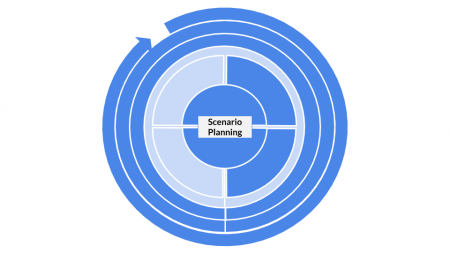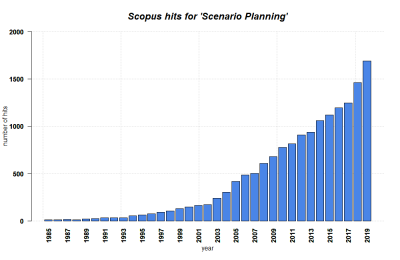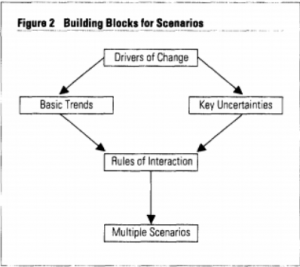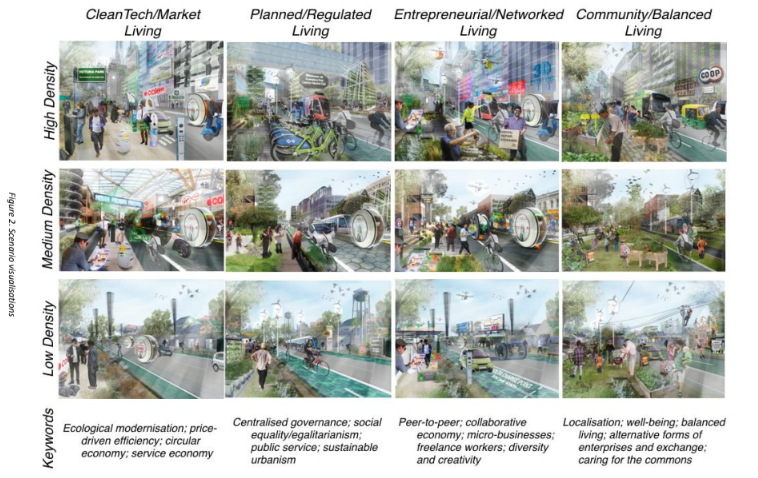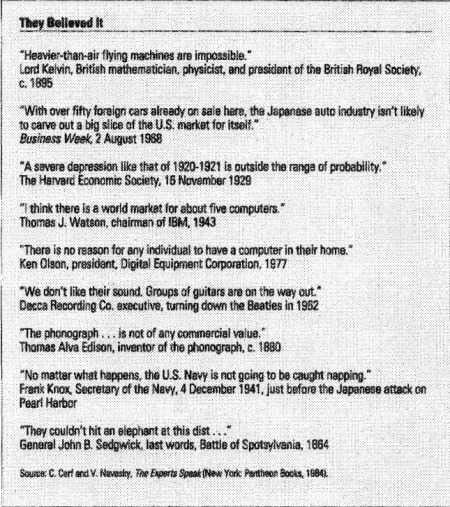Difference between revisions of "Scenario Planning"
| Line 24: | Line 24: | ||
'''Shortly after, Scenario Planning was heavily furthered through corporate planning, most notably by the oil company Shell.''' At the time, corporate planning was traditionally "(...) based on forecasts, which worked reasonably well in the relatively stable 1950s and 1960s. Since the early 1970s, however, forecasting errors have become more frequent and occasionally of dramatic and unprecedented magnitude." (Wack 1985, p.73). As a response to this and to be prepared for potential market shocks, Shell introduced the "Unified Planning Machinery". The idea was to listen to planners' analysis of the global business environment in 1965 and, by doing so, Shell practically invented Scenario Planning. The system enabled Shell to first look ahead for six years, before expanding their planning horizon until 2000. The scenarios prepared Shell's management to deal with the 1973 and 1981 oil crises (1). Shell's success popularized the method. By 1982, more than 50% of Fortune 500 (= the 500 highest-grossing US companies) had switched to Scenario Planning (2). | '''Shortly after, Scenario Planning was heavily furthered through corporate planning, most notably by the oil company Shell.''' At the time, corporate planning was traditionally "(...) based on forecasts, which worked reasonably well in the relatively stable 1950s and 1960s. Since the early 1970s, however, forecasting errors have become more frequent and occasionally of dramatic and unprecedented magnitude." (Wack 1985, p.73). As a response to this and to be prepared for potential market shocks, Shell introduced the "Unified Planning Machinery". The idea was to listen to planners' analysis of the global business environment in 1965 and, by doing so, Shell practically invented Scenario Planning. The system enabled Shell to first look ahead for six years, before expanding their planning horizon until 2000. The scenarios prepared Shell's management to deal with the 1973 and 1981 oil crises (1). Shell's success popularized the method. By 1982, more than 50% of Fortune 500 (= the 500 highest-grossing US companies) had switched to Scenario Planning (2). | ||
| − | Today, Scenario Planning remains an important tool for corporate planning in the face of increasing complexity and uncertainty in business environments (5). Adjacent to [[Visioning | + | Today, Scenario Planning remains an important tool for corporate planning in the face of increasing complexity and uncertainty in business environments (5). Adjacent to [[Visioning & Backcasting]], it has also found its way into research. For instance, researchers in transdisciplinary sustainability science gather stakeholders' expertise to think about (un)desirable states of the future and how (not) to get there. This way, companies, non-governmental organizations, cities and even national states can be advised and supported in their planning. |
== What the method does == | == What the method does == | ||
| Line 52: | Line 52: | ||
* Scenario Planning broadens the structural perspective of an actor to think about the future (5). For example, an oil company may well be able to assess risks in their technical processes of oil exploration and extraction, but only through a more detailed scenario analysis they may be enabled to include economic, political and societal trends into their planning (2). | * Scenario Planning broadens the structural perspective of an actor to think about the future (5). For example, an oil company may well be able to assess risks in their technical processes of oil exploration and extraction, but only through a more detailed scenario analysis they may be enabled to include economic, political and societal trends into their planning (2). | ||
* Scenarios are psychologically attractive. They are a way of transforming seemingly disparate data into relatable, coherent narratives. They present uncertainty across scenarios instead of providing probabilistic information for all elements within each individual one. In addition, they reduce the complexity of the future into graspable states (2). | * Scenarios are psychologically attractive. They are a way of transforming seemingly disparate data into relatable, coherent narratives. They present uncertainty across scenarios instead of providing probabilistic information for all elements within each individual one. In addition, they reduce the complexity of the future into graspable states (2). | ||
| − | * Scenario Planning differs from adjacent methodological approaches. While a ''scenario'' illustrates a possible state of the future, a ''vision'' (see [[Visioning | + | * Scenario Planning differs from adjacent methodological approaches. While a ''scenario'' illustrates a possible state of the future, a ''vision'' (see [[Visioning & Backcasting]] revolve around a desirable state of the future without taking its likelihood into consideration. A ''prediction'' as the classical method of economic ''forecasting'', describes likely states of the future as an extension of current developments, without the openness for change that is inherent to Scenario Planning. Compared to Visioning, Scenario Planning might therefore be more useful for actual decision-making but might as well be too narrow to envision holistic systemic changes (6). |
'''Good scenarios should fulfill a range of characteristics''' (3, 5): | '''Good scenarios should fulfill a range of characteristics''' (3, 5): | ||
| Line 68: | Line 68: | ||
* Scenario Planning is connected to various other methodological approaches. First, it is based on a [[System Thinking and Causal Loop Diagrams|System Thinking]] approach, recognizing the interconnectedness and causal interference of elements within a system. | * Scenario Planning is connected to various other methodological approaches. First, it is based on a [[System Thinking and Causal Loop Diagrams|System Thinking]] approach, recognizing the interconnectedness and causal interference of elements within a system. | ||
* To gather a good understanding of the relevant stakeholders and trends, useful approaches are [[Social Network Analysis]] or [[Stakeholder Analysis]]. To support the analysis of how systemic variables interact with each other, []Agent Based Modelling]] may be applied. | * To gather a good understanding of the relevant stakeholders and trends, useful approaches are [[Social Network Analysis]] or [[Stakeholder Analysis]]. To support the analysis of how systemic variables interact with each other, []Agent Based Modelling]] may be applied. | ||
| − | * Scenario Planning may be done after a [[Visioning | + | * Scenario Planning may be done after a [[Visioning & Backcasting|Visioning]] process: after envisioning what is desirable, stakeholders may think about what is actually realistic (4). |
* Scenario Planning is to some extent comparable to the [[Delphi]], where experts share their opinions on the future of an issue and come to a joint prediction. However, Scenario Planning differs in that it attempts to develop several complex scenarios instead of reaching one single (often quantitative) result to a question. | * Scenario Planning is to some extent comparable to the [[Delphi]], where experts share their opinions on the future of an issue and come to a joint prediction. However, Scenario Planning differs in that it attempts to develop several complex scenarios instead of reaching one single (often quantitative) result to a question. | ||
Revision as of 10:42, 20 January 2021
| Method categorization | ||
|---|---|---|
| Quantitative | Qualitative | |
| Inductive | Deductive | |
| Individual | System | Global |
| Past | Present | Future |
In short: Scenario Planning is a systematic designation of potential futures to enable long term strategic planning.
Background
The use of scenarios as a tool for structured thinking about the future dates back to the Manhattan Project in the early 1940s. The physicists involved in developing the atomic bomb attempted to estimate the consequences of its explosion and employed computer simulations to do so. Subsequently, this approach advanced in three separate strands: computer simulations, game theory, and military planning through, among others, the RAND corporation that also developed the Delphi Method]. Later, during the 1960s, scenarios were "(...) extensively used for social forecasting, public policy analysis and decision making" in the US. (Amer et al. 2013, p.24).
Shortly after, Scenario Planning was heavily furthered through corporate planning, most notably by the oil company Shell. At the time, corporate planning was traditionally "(...) based on forecasts, which worked reasonably well in the relatively stable 1950s and 1960s. Since the early 1970s, however, forecasting errors have become more frequent and occasionally of dramatic and unprecedented magnitude." (Wack 1985, p.73). As a response to this and to be prepared for potential market shocks, Shell introduced the "Unified Planning Machinery". The idea was to listen to planners' analysis of the global business environment in 1965 and, by doing so, Shell practically invented Scenario Planning. The system enabled Shell to first look ahead for six years, before expanding their planning horizon until 2000. The scenarios prepared Shell's management to deal with the 1973 and 1981 oil crises (1). Shell's success popularized the method. By 1982, more than 50% of Fortune 500 (= the 500 highest-grossing US companies) had switched to Scenario Planning (2).
Today, Scenario Planning remains an important tool for corporate planning in the face of increasing complexity and uncertainty in business environments (5). Adjacent to Visioning & Backcasting, it has also found its way into research. For instance, researchers in transdisciplinary sustainability science gather stakeholders' expertise to think about (un)desirable states of the future and how (not) to get there. This way, companies, non-governmental organizations, cities and even national states can be advised and supported in their planning.
What the method does
Scenario Planning is the systematic development of descriptions of (typically) multiple plausible futures, which are then called "scenarios". These descriptions of plausible futures may be illustrated with quantitative and precise details. However, the focus lies on presenting them "(...) in coherent script-like or narrative fashion." (Schoemaker 1993, p.195). The scenarios developed in a Scenario Planning process are all "fundamentally different" (Schoemaker 1993, p.195) and may be contradictory and irreconcilable, but there is no inherent ranking between them (2). The core idea is not to present the most probable version of the future, but to get an idea about the range of possible developments of system variables and their interactions (2, 5). Scenarios "(...) are not states of nature nor statistical predictions. The focus is not on single-line forecasting nor on fully estimating probability distributions, but rather on bounding and better understanding future uncertainties." (Schoemaker 1993, p.196).
There is no one procedure for Scenario Planning (5). A commonly cited approach was by Schoemaker (2, 3) includes the following steps:
1) Definition of time frame, scope, decision variables and major actors of the issue in question.
2) Identification of current trends and predetermined elements and how they influence the defined decision variables, based on the knowledge of experts and the available data. It should be observed whether major trends are compatible with each other and which uncertainties exist.
3) Construction of extreme future states along a specific continuum (positive vs negative, probable vs surprising, continuous vs divergent) for all the elements or variables. These extremes are then assessed for their internal consistency and plausibility in terms of stakeholder decisions, trends and outcomes.
4) Elimination of implausible or impossible futures and, based on the themes that emerged from these, the creation of new scenarios. This process is repeatedly done until internally consistent scenarios are found. The number of scenarios developed depends on the scope and purpose of the planning process (1, 5).
5) The preliminary scenarios are analysed in terms of which decisions would need to be taken by the key stakeholders to reach them, and potentially revised again when further investigation of these scenarios brings up additional or contradictory knowledge about them. The scenarios may also be transferred into quantitative models to learn about the development and inherent uncertainties of individual variables.
6) Finally, these preliminary scenarios are re-iterated by going through the previous steps again, checking for their applicability to the issue at hand, until finally, scenarios emerge that can be used for planning processes.
Strenghts & Challenges
- Scenario Planning allows for any organization that deploys it to be more innovative, flexible and thus better prepared for unforeseen disruptions and changes. In a corporate context, this can reduce costs, provide market benefits and improve internal communication (3, 5).
- Scenario Planning broadens the structural perspective of an actor to think about the future (5). For example, an oil company may well be able to assess risks in their technical processes of oil exploration and extraction, but only through a more detailed scenario analysis they may be enabled to include economic, political and societal trends into their planning (2).
- Scenarios are psychologically attractive. They are a way of transforming seemingly disparate data into relatable, coherent narratives. They present uncertainty across scenarios instead of providing probabilistic information for all elements within each individual one. In addition, they reduce the complexity of the future into graspable states (2).
- Scenario Planning differs from adjacent methodological approaches. While a scenario illustrates a possible state of the future, a vision (see Visioning & Backcasting revolve around a desirable state of the future without taking its likelihood into consideration. A prediction as the classical method of economic forecasting, describes likely states of the future as an extension of current developments, without the openness for change that is inherent to Scenario Planning. Compared to Visioning, Scenario Planning might therefore be more useful for actual decision-making but might as well be too narrow to envision holistic systemic changes (6).
Good scenarios should fulfill a range of characteristics (3, 5):
- They need to be plausible and internally consistent, i.e. capable of happening.
- They should be relevant, i.e. of help for decision making and connected to the issue to be solved.
- They should be archetypal, i.e. not represent variations on the same theme but describe distinct futures.
- They should describe a future that is in a state in which "the system might exist for some length of time, as opposed to being highly transient." (Schoemaker 1995, p.30)
- They should challenge the existent way of thinking about the future.
- While Scenario Planning generally permits actors to broaden their perspective, this only works if the construction of scenarios is not biased, which easily happens (2, 3). One may unconsciously look for confirming evidence for personal presuppositions when identifying trends and uncertainties. Also, overconfidence that certain trends will (not) prevail may distort one's assessment. This should be paid attention to during the process (3). As Schoemaker (1995, p.38) puts it: "When contemplating the future, it is useful to consider three classes of knowledge: 1. Things we know we know. 2. Things we know we don't know. 3. Things we don't know we don't know. Various biases (...) plague all three, but the greatest havoc is caused by the third." Ignorance in terms of the future should be acknowledged and addressed in order to challenge biases. "And this is where scenario planning excels, since it is essentially a study of our collective ignorance." (ibid).
Normativity
Connectedness
- Scenario Planning is connected to various other methodological approaches. First, it is based on a System Thinking approach, recognizing the interconnectedness and causal interference of elements within a system.
- To gather a good understanding of the relevant stakeholders and trends, useful approaches are Social Network Analysis or Stakeholder Analysis. To support the analysis of how systemic variables interact with each other, []Agent Based Modelling]] may be applied.
- Scenario Planning may be done after a Visioning process: after envisioning what is desirable, stakeholders may think about what is actually realistic (4).
- Scenario Planning is to some extent comparable to the Delphi, where experts share their opinions on the future of an issue and come to a joint prediction. However, Scenario Planning differs in that it attempts to develop several complex scenarios instead of reaching one single (often quantitative) result to a question.
Everything normative about this method
- The aforementioned distinct ways of planning for the future differ from each other not only in the process, but also on a normative dimension. The world how it should be-way of thinking in a Visioning approach is highly normative. In forecasting*, it is assumed that the world does not change much, which is often the case, but also often not. Scenario Planning, by comparison, assumes that the world could be changing and takes the possible changes and their consequences into consideration. It is a matter of how a company, a person or a scientists views the world that decides upon the approach that is taken to think about the future (see (1)). In a highly complex and dynamic world such as ours today, it may be advisable to consider the possibility of changing circumstances. As Wack (1985, p.73) puts it: "The future is no longer stable; it has become a moving target. No single "right" projection can be deduced from past behavior."
- As Wack (1985) highlights, developing good scenarios is not sufficient to foster action in decision-makers. Scenarios should also be able to "(...) change the decision-makers' assumptions about how the world works and compel them to reorganize their mental model of reality." (Wack 1985, p.74). Scenario Planning must be accompanied by a transformational mindset shift in the respective organization (i.e. state, company, community). This may be hard, because it challenges fond concepts of how the world works. Therefore, "[s]cenario planning requires intellectual courage to reveal evidence that does not fit our current conceptual maps, especially when it threatens our very existence. (...) But (...) opportunities can be perceived only when you actively look for them. (...) In addition to perceiving richer options, however, we must also have the courage and vision to act on them." (Schoemaker 1995, p.39)
Outlook
It is fair to say that maybe more than ever, a constant of our time is that nothing remains as it is. New developments, such as AI, genetic engineering, space travel and many more, partly unforeseeable (technological) changes make it reasonable to apply more systematic approaches on thinking about the future that challenge our presupposition. Several experts people saw the COVID-19 pandemic coming, others did not, and many countries were not sufficiently prepared for it. Scenario Planning may be one approach that helps decision-makers to plan for states of the future that may arise, and especially to steer developments into the directions of desirable ones (see 1, 5).
Key Publications
- Wack, P. 1985. Scenarios: uncharted waters ahead. Harvard Business Review 63(5). 72-89.
A first-hand report from inside of Shell's planning process in the 1960s.
- Schoemaker, P.J.H. 1995. Scenario Planning: A Tool for Strategic Thinking. Sloan Management Review 36(2). 25-50.
A detailed description of how to conduct Scenario Planning, explained through case studies in the advertisement industry.
- Amer, M. Daim, T.U. Jetter, A. 2013. A review of scenario planning. Futures 46. 23-40.
A (rather complex) overview on different types of Scenario Planning across the literature.
- Swart, R.J., Raskin, P., Robinson, J. 2004. The problem of the future: sustainability science and scenario analysis. Global Environmental Change 14(2). 137-146.
A conceptual paper that elaborates on the potential of scenarios in and for sustainability science.
References
- (1) Wack, P. 1985. Scenarios: uncharted waters ahead. Harvard Business Review 63(5). 72-89.
- (2) Schoemaker, P.J.H. 1993. Multiple Scenario Development: Its Conceptual and Behavioral Foundation. Strategic Management Journal 14(3). 193-213.
- (3) Schoemaker, P.J.H. 1995. Scenario Planning: A Tool for Strategic Thinking. Sloan Management Review 36(2). 25-50.
- (4) Gaziulusoy, a.I. Ryan, C. 2017. Shifting Conversations for Sustainability Transitions Using Participatory Design Visioning. The Design Journal 20(1). 1916-1926.
- (5) Amer, M. Daim, T.U. Jetter, A. 2013. A review of scenario planning. Futures 46. 23-40.
- (6) Wiek et al. 2006. Functions of scenarios in transition processes. Futures 38(7). 740-766.
The author of this entry is Christopher Franz.
